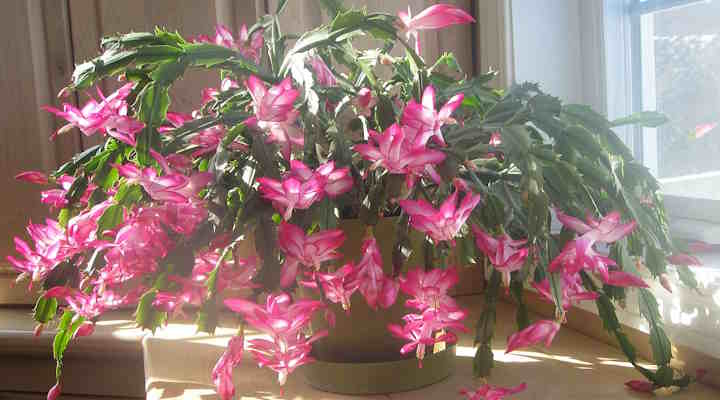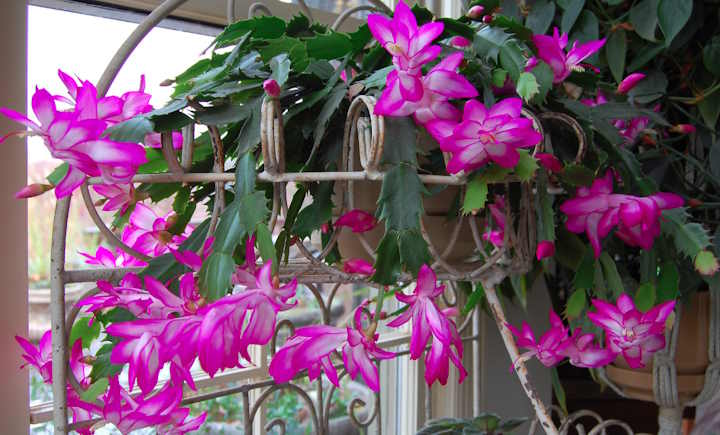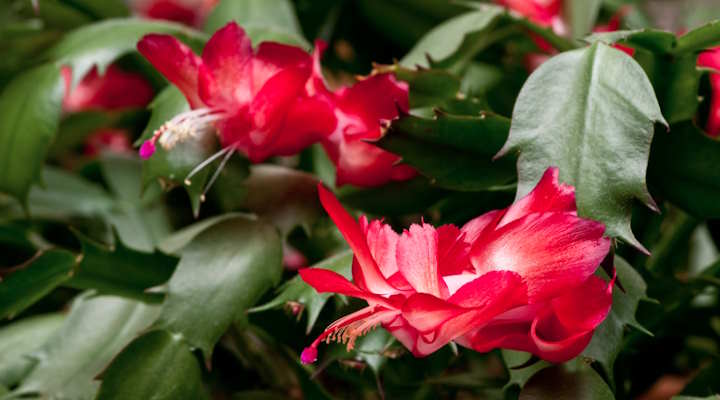Why Your Christmas Cactus Isn’t Blooming and How to Fix It Fast

The Christmas Cactus (Schlumbergera × buckleyi) is an attractive houseplant known for its vibrant, festive blooms that light up the winter season. Unlike many plants, this unique cactus thrives in the colder months, making it a popular addition to holiday decorations and a symbol of seasonal cheer.
But getting your Christmas Cactus to bloom year after year can sometimes feel like a mystery. How can you care for it in order to produce those stunning, colorful flowers? In this article, we’ll explore how to help your Christmas Cactus bloom during the holiday season and share other important care tips to keep it healthy and thriving.
Understanding Christmas Cactus and Its Blooming Cycle
What is Christmas Cactus?
Unlike the prickly desert cacti we usually think of, the Christmas Cactus is native to the tropical rainforests of Brazil. It thrives in cooler temperatures and humidity, making it a perfect fit for indoor environments. This plant is easily recognized by its unique, segmented leaves and vibrant flowers that can come in shades of red, pink, white, or purple.
When Does Christmas Cactus Bloom?
The Christmas Cactus blooms from late November to early January. Unlike many plants that have a short bloom period, the Christmas Cactus is known for being a long-bloomer, often continuing to show off its vibrant flowers for several weeks. Its extended bloom period means you can enjoy the festive colors for weeks, making it a perfect plant to keep your space bright and festive throughout the holiday season.

Image: Mark Levisay, Flickr
How to Make Your Christmas Cactus Bloom
If you’ve been hoping to get your Christmas Cactus to bloom, a little care and attention to its needs can go a long way. Here’s how to get your plant in the right conditions for those stunning flowers.
Light and Temperature Requirements
For the best results, give your Christmas Cactus bright but indirect light. Too much direct sunlight can actually harm it, and too little can prevent it from blooming. It loves a cozy spot that’s well-lit but not directly in the sun. As for temperature, this cactus needs a cool period of about 50-55°F (10-13°C) for about 2-3 weeks to trigger the blooming process.
The Importance of Darkness: Light Control for Flowering
Christmas Cactus is a “short-day” plant, meaning it needs long, dark nights to start blooming. For 2-3 weeks, it should be exposed to 12-14 hours of darkness each day. That might sound tricky, but you can easily manage this by placing it in a dark room or covering it at night with a cloth or bag.
Watering Christmas Cactus Before Blooming
When preparing your cactus for its big bloom, be mindful of your watering habits. Keep the soil a little drier than usual to avoid letting it get too soggy. This helps your plant focus its energy on developing buds, rather than encouraging too much growth.
Fertilizing for Flower Production
A little fertilizer goes a long way in helping your cactus bloom. Use a balanced, diluted fertilizer once a month during the growing season to support healthy growth. But, once your cactus starts to bloom, cut back on fertilizing. Over-fertilizing during this time can interfere with the flowers.

Caring for Your Christmas Cactus Year-Round
If you want your plant to stay healthy and vibrant throughout the year, there are a few key aspects to consider.
Proper Watering and Drainage
Christmas Cactus is a bit different from its desert cousins, and watering it properly is crucial. To keep your plant happy, only water it when the top 1-2 inches of soil feel dry. Overwatering can be a problem, so avoid letting it sit in water as this can lead to root rot. A good cactus or succulent mix, which provides excellent drainage, is perfect for this plant.
Humidity and Air Circulation
The Christmas Cactus thrives in moderately humid conditions. While it can adapt to indoor environments, it benefits from added humidity in drier areas. Placing a tray of water with pebbles nearby or using a humidifier can help maintain the right moisture levels. Good air circulation is equally important, so choose a spot where air flows freely to prevent stagnant conditions that can encourage disease.
Pest Control
While the Christmas Cactus is generally a tough plant, pests like mealybugs, spider mites, and aphids can still cause trouble. Make sure to regularly check for signs of potential pests, especially around the joints and under the leaves. If you notice any pests on your Christmas Cactus, you can simply wipe them off with a damp cloth or use insecticidal soap for a more targeted approach. If you are using insecticidal soap, just be sure to test a small area first, as it can damage some plants.
Pruning and Maintaining Healthy Growth
Pruning your Christmas Cactus at the right time can make a big difference in how it looks and blooms next year. After the blooming season ends, take the time to prune any leggy or old growth. Pruning encourages the plant to grow more branches and gives you the potential for more flowers in the next cycle. Just make sure to do it after the blooms have faded. If you prune too early, it could disrupt the blooming process.
Signs of Stress and Disease
If you notice wilting, yellowing leaves, or a lack of blooms, it might be time to investigate. Wilting can indicate too much water or not enough, while yellow leaves might point to a nutrient deficiency or poor lighting. If your cactus isn’t blooming, check the light levels or ensure it’s getting the cool temperatures it needs to trigger blooming.

Image: Dwight Sipler, Flickr
Troubleshooting: What to Do If Your Christmas Cactus Isn’t Blooming
If your Christmas Cactus isn’t blooming, here’s what might be going wrong and how to turn things around.
Not Enough Light or Temperature Control
Your cactus needs bright, indirect light and cooler nights to prepare for blooming. Without these, no flowers will appear.
Overwatering or Poor Drainage
Too much water drowns the roots. Make sure your pot has good drainage and let the soil dry out a bit between waterings.
Age and Health of the Plant
Older plants sometimes take a year or two to bloom after being moved or stressed. Be patient and keep caring for it.
Too Much Fertilizer
Using too much fertilizer, especially with high nitrogen, encourages leaves, not flowers. Reduce how often you fertilize and choose one that’s gentle and flower-focused.
Suggestions for Reviving a Dormant Plant
To wake up a dormant cactus, reduce watering and give it 12-14 hours of darkness daily for a few weeks.

Image: Empereur Day, Wikimedia Commons
Post-Bloom Care: What to Do After Your Christmas Cactus Has Bloomed
Transitioning the Plant After the Blooming Season
After the bloom period, gradually increase watering as the plant transitions out of its dormant phase. Use a balanced, gentle fertilizer every month to support healthy growth.
Storing the Cactus After Blooming
The Christmas Cactus needs a rest period to recharge. Place the plant in a cooler spot with indirect light and ease back on watering for about 6-8 weeks. This rest period helps the plant store energy for the next blooming cycle.
Minimize Disturbance During Resting Period
Keep your Christmas Cactus in a stable environment during its resting phase. Frequent moving or changes in location can stress the plant, leading to bud drop or stunted growth.
Repotting (If Needed)
If your plant has outgrown its pot, this is a great time to repot it. Choose a container that’s slightly larger with fresh, well-draining soil to give it room to grow.
Resuming Regular Care
After the bloom period, gradually increase watering as the plant transitions out of its dormant phase. Use a balanced, gentle fertilizer every month to support healthy growth.
Frequently Asked Questions (FAQs)
How do I get my Christmas Cactus to bloom again next year?
After blooming, make sure to give your Christmas Cactus a rest period by reducing watering and keeping it in a cool, dry place for about 4-6 weeks. Then, once it’s out of its dormancy phase, gradually resume regular watering and place it in a brighter location to encourage blooming again next year.
My Christmas Cactus isn’t blooming—what am I doing wrong?
A lack of bloom can often be attributed to insufficient light or temperature regulation. Ensure your cactus is getting at least 12-14 hours of darkness each day for 2-3 weeks before the blooming season. Temperature is also important—try to keep it between 50-55°F (10-13°C) during this period to stimulate the flowers.
Can I prune my Christmas Cactus while it’s blooming?
It’s best to avoid pruning during the blooming period. Wait until after the flowers have fallen off, then trim the plant to maintain its shape and encourage healthier growth for the next blooming cycle.
How can I tell if my Christmas Cactus is overwatered?
Common signs of an overwatered Christmas Cactus include yellowing leaves, mushy stems, or a soggy base. To prevent this, ensure that your cactus has well-draining soil and avoid letting it sit in water. Always allow the soil to dry out slightly before watering again.
Can I use regular potting soil for my Christmas Cactus?
It’s recommended to use a well-draining cactus or succulent mix. Regular potting soil may retain too much moisture, which can cause root rot. If you only have regular soil, consider mixing it with perlite or sand to improve drainage.
My Christmas Cactus seems to be dropping buds before they bloom. What should I do?
Bud drop can occur due to environmental stress, such as sudden changes in light, temperature, or humidity. Ensure that your cactus isn’t being moved frequently, and avoid exposing it to drafts or extreme temperature fluctuations, which can cause the buds to fall prematurely.
How often should I fertilize my Christmas Cactus?
During the growing season (spring and summer), fertilize your Christmas Cactus every 4-6 weeks with a balanced, diluted fertilizer. Once the plant begins to bloom, stop fertilizing to allow the flowers to take center stage without any interference.
Can I leave my Christmas Cactus outside during the warmer months?
Yes, your Christmas Cactus can be placed outside during the warmer months, but make sure to choose a location with indirect sunlight. Avoid direct sunlight, which can scorch the plant. When the weather turns cold, bring it back inside to protect it from frost.
Why isn’t my Christmas Cactus growing or blooming as expected?
Lack of growth and poor blooming can be caused by several factors, including too much direct sunlight, inadequate watering, or incorrect temperature conditions. Review the care tips in the article to ensure your cactus is receiving optimal conditions for growth and bloom.
